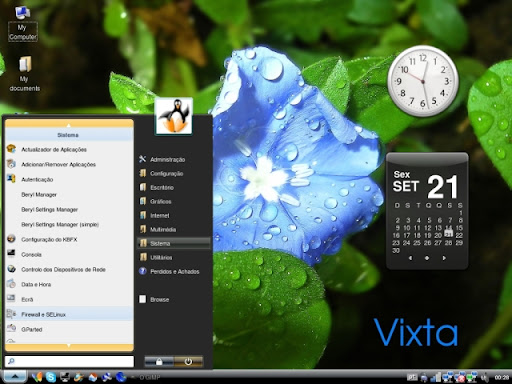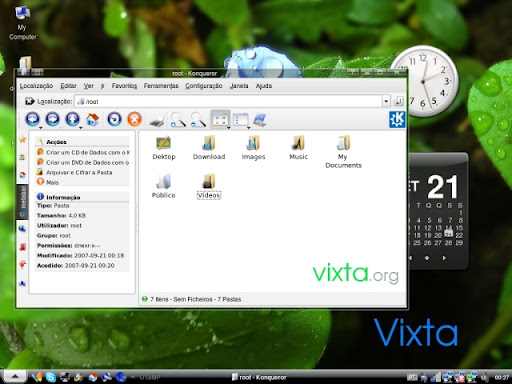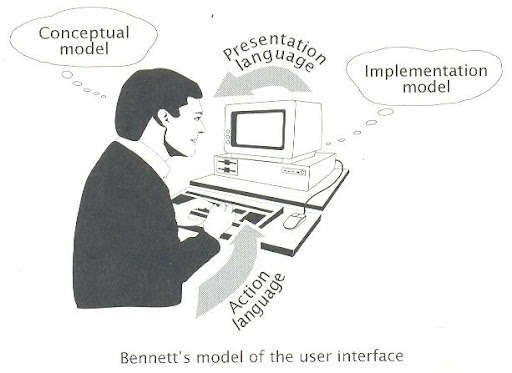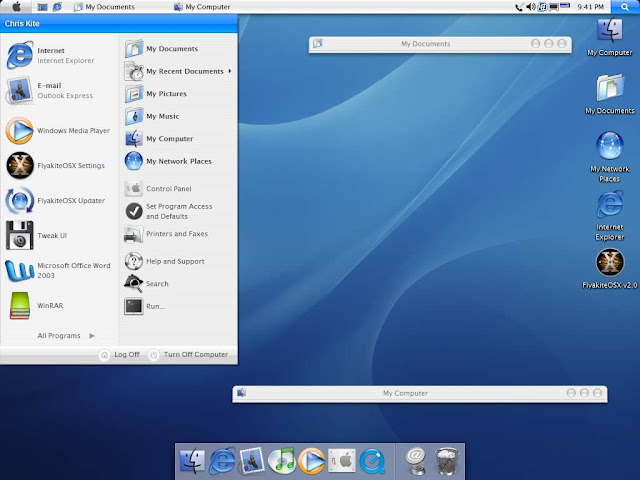這幾天看到一個有趣的 Desktop Linux Distro. : Vixta Linux. (以下 screenshots 取自 Vixta@S.F.net)
 Vixta 是以 Fedora 8 為基礎作修改的 Desktop Linux Distro. , 從名稱以及外觀不難看出來是 follow Windows Vista 的 style. 雖然模仿 Windows style 這不是第一樁, 但是在隨著 EeePC 使得 Linux 能見度再度提高的同時, 出現了跟 Windows Vista 極為相似的 Linux Desktop, 還是比起之前對於 Windows 2k, XP 的模仿更具意義. 而即便是在一些操作的介面上, 例如 File Manager, 也弄得很接近 Windows 傳統的方式. (不過其實原本 Konqueror 的 side bar 比較 powerful)
Vixta 是以 Fedora 8 為基礎作修改的 Desktop Linux Distro. , 從名稱以及外觀不難看出來是 follow Windows Vista 的 style. 雖然模仿 Windows style 這不是第一樁, 但是在隨著 EeePC 使得 Linux 能見度再度提高的同時, 出現了跟 Windows Vista 極為相似的 Linux Desktop, 還是比起之前對於 Windows 2k, XP 的模仿更具意義. 而即便是在一些操作的介面上, 例如 File Manager, 也弄得很接近 Windows 傳統的方式. (不過其實原本 Konqueror 的 side bar 比較 powerful) 這樣的模仿, 目的之一當然是希望能夠混淆視聽, 讓使用者分不出來這是 Linux 還是 Windows Vista, 以達到想要的結果, 也就是寫在 Vixta Goals 裡的 : Spread linux to the "masses", User-Friendly, 以及 Familiar look and Feel.
這樣的模仿, 目的之一當然是希望能夠混淆視聽, 讓使用者分不出來這是 Linux 還是 Windows Vista, 以達到想要的結果, 也就是寫在 Vixta Goals 裡的 : Spread linux to the "masses", User-Friendly, 以及 Familiar look and Feel.假設 Vixta 可以達到他想要的效果好了, 這意味著使用者無法在使用 Vixta 時分清楚究竟現在他用的是 Linux 系統還是 Windows 系統, 要達到這個程度, 不是只改改 layout 介面就可以作到的. Software GUI 的真正意涵在於連接 Software 的運作邏輯 (Software Implementation Model) 與 User 的使用邏輯 (User's Conceptual Model) [1][2], 而通常後者的可變動性 (flexibility) 是比較大的, 因此可以說 Software GUI 是決定了怎樣把 Software 的運作邏輯表現給 User, 使得 User 可以在最小修正使用邏輯的前提下, 最有效率地利用該 Software. 而如果今天出現了一個 Software GUI, 可以讓 User 察覺不到背後的系統更換, 那麼被更換的兩個系統, 與 Software GUI 之間必定有相當程度的 decoupling -- 換句話說, 在 Software GUI 與背後的系統之間有相當清楚的 Interface 存在.
D. Collins 在 [1] 中引用了 J. Bennett 的 model [3][4], 訴說 User Interface 中四個不同的主要部分 : (the figure bellow is referenced form [1] )
 圖中的 Implementation Model 是同時包含了 hardware 以及 software 的部分. 可以看的出來各部分之間的 coupling 關係, 使得要完成一個完整的 Software User Interface Copy 是很難的事情, 因為多多少少不同的系統在 Implementation Model 上都有差異, 也會影響到 Presentation Language 以及 Action Language 的呈現. 如果為了 Copy 而去改變 Implementation Model 就有點本末倒置了. 我相信 Vixta 總不會為了要讓 User Interface 更像 Vista 一點而去改 Linux 系統本身吧.
圖中的 Implementation Model 是同時包含了 hardware 以及 software 的部分. 可以看的出來各部分之間的 coupling 關係, 使得要完成一個完整的 Software User Interface Copy 是很難的事情, 因為多多少少不同的系統在 Implementation Model 上都有差異, 也會影響到 Presentation Language 以及 Action Language 的呈現. 如果為了 Copy 而去改變 Implementation Model 就有點本末倒置了. 我相信 Vixta 總不會為了要讓 User Interface 更像 Vista 一點而去改 Linux 系統本身吧.但是這是不是意味著 Software User Interface Separation (from Functional Application Part) 是不可能的呢 ? 我覺得倒也未必, 只是可能不會由目前的模仿之路作到, 而是透過 UI Design Patterns 的路作到. 重點還是在於 User 是否需要這樣的東西.
即便在 Windows 上也是有許多嘗試改變 Windows 預設 User Interface 的 softwares 存在, 例如比較有名的可能是仿 Mac 的 FlyakiteOSX, (figure bellow is referred from Screeshots@FlyakiteOSX)
 這下好了, 用 Linux 的人在用 Windows 的 Desktop, 用 Windows 的人改用 Mac 的 Desktop, 下一個會是誰用誰的呢 ? 但是可以肯定的是, 只要 User 有這樣需求的一天, User Interface Separation 的可能性就一直存在, 差別可能只在於會在哪出現, 是在 OS 上, 還是會率先在 Web Applications 上出現呢 ?
這下好了, 用 Linux 的人在用 Windows 的 Desktop, 用 Windows 的人改用 Mac 的 Desktop, 下一個會是誰用誰的呢 ? 但是可以肯定的是, 只要 User 有這樣需求的一天, User Interface Separation 的可能性就一直存在, 差別可能只在於會在哪出現, 是在 OS 上, 還是會率先在 Web Applications 上出現呢 ?References
[1] Dave Collins, Designing Object-Oriented User Interfaces, Addison-Wesley, 1995
[2] Theo Mandel, The Elements of User Interface Design, Wiley, 1997.
[3] John Bennett, "User-Oriented Graphics Systems for Decision Support in Unstructured Tasks," ACM SIGGRAPH, 1977
[4] John Bennett, "Analysis and Design of the User Interface for Decision Support Systems," In Building Decision Support Systems, Addison-Wesley, 1983
沒有留言:
張貼留言